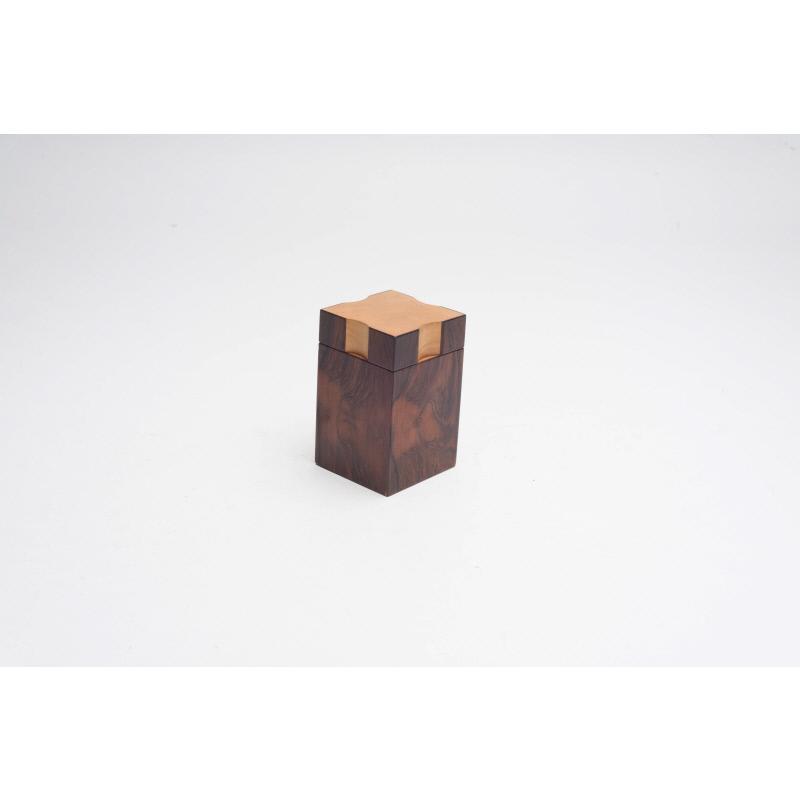Stud box
Classification(s):
Wood
Date: 1965
Organisation: John Makepeace
Dimensions:
119 × 76 mm (11.9 × 7.6 cm)
Medium: Wood
Object number: W565E
See Also
Place of Production:England
Title:Ionic
DescriptionStud box with lid by John Makepeace. Made in England. The box’s lid is attached to the interior base of the box by a metal linked chain. The stud box is made from sycamore and rosewood veneer and is from the ‘Ionic’ range of desk and shelf accessories developed by Makepeace in the mid-1960s. The Ionic range sold successfully in the leading London furniture store Heal’s.
ProvenanceThis object was originally acquired from Farnborobarn.
This object was originally acquired for the Inner London Education Authority’s (ILEA) ‘Circulating Design Scheme’ collection.
The collection was instigated by the London Country Council (later the Greater London Council) and the Council of Industrial Design (COID). The collection’s original purpose was concerned with the teaching and dissemination of modern, ‘good design’.
The collection was established in 1951/52 as the ‘Experiment in Design Appreciation’, later renamed the ‘Circulating Design Scheme’.
The Circulating Design Scheme lent boxed showcases to London schools. The showcases contained handling objects, material samples and interpretation on a specific subject.
COID withdrew its involvement in the Scheme in 1957. After which time, it was managed exclusively by the London County Council from 1957-1963.
After the administrative restructuring of London authorities, the Scheme was jointly managed by the Greater London Council and the Inner London Education Authority (ILEA) from 1963 – 1976.
The Scheme was operational until 1976 when the collections were withdrawn from circulation. ILEA was abolished in the late 1980s and the collection was donated to Camberwell College of Arts in 1989/90.
ILEA was responsible for secondary and tertiary education in the inner London boroughs, this included Camberwell.
This object was originally acquired for the Inner London Education Authority’s (ILEA) ‘Circulating Design Scheme’ collection.
The collection was instigated by the London Country Council (later the Greater London Council) and the Council of Industrial Design (COID). The collection’s original purpose was concerned with the teaching and dissemination of modern, ‘good design’.
The collection was established in 1951/52 as the ‘Experiment in Design Appreciation’, later renamed the ‘Circulating Design Scheme’.
The Circulating Design Scheme lent boxed showcases to London schools. The showcases contained handling objects, material samples and interpretation on a specific subject.
COID withdrew its involvement in the Scheme in 1957. After which time, it was managed exclusively by the London County Council from 1957-1963.
After the administrative restructuring of London authorities, the Scheme was jointly managed by the Greater London Council and the Inner London Education Authority (ILEA) from 1963 – 1976.
The Scheme was operational until 1976 when the collections were withdrawn from circulation. ILEA was abolished in the late 1980s and the collection was donated to Camberwell College of Arts in 1989/90.
ILEA was responsible for secondary and tertiary education in the inner London boroughs, this included Camberwell.
NotesThis object was circulated to London schools as part of the Inner London Education Authority’s (I.L.E.A) Circulating Design Scheme, which operated from 1951-1976. The stud box featured in the ‘Modern British Glass, Pottery, Metal, Wood and Textiles’ group in case number 1. The boxed showcase investigates the work of Industrial Designers in a more detailed way. The boxed showcase describes the role of the Industrial Designer as “determining much of the quality of domestic, social and working life in the machine age”. The text suggests to successfully work within an economic framework for large-scale production, the Industrial Designer must “see the technical, economic, human and aesthetic factors involved in product designing as an integrated whole”. The text also describes the design method as involving, an analytical study of the problem, a report containing market information, a design brief and a sequence of design prototypes. This object was originally acquired from Farnborobarn. The associated record card indicates the boxed showcase was in use from 1970-76. Original photograph of boxed showcase copyright Harold King (Photography) Ltd, Morden, Surrey.









